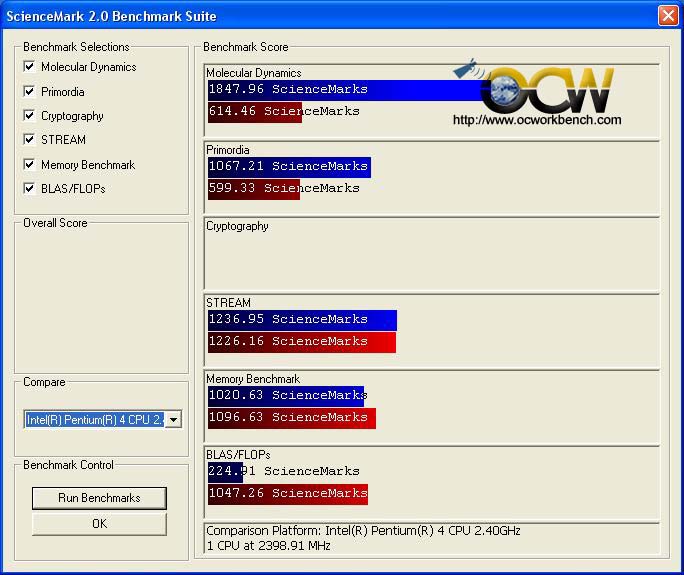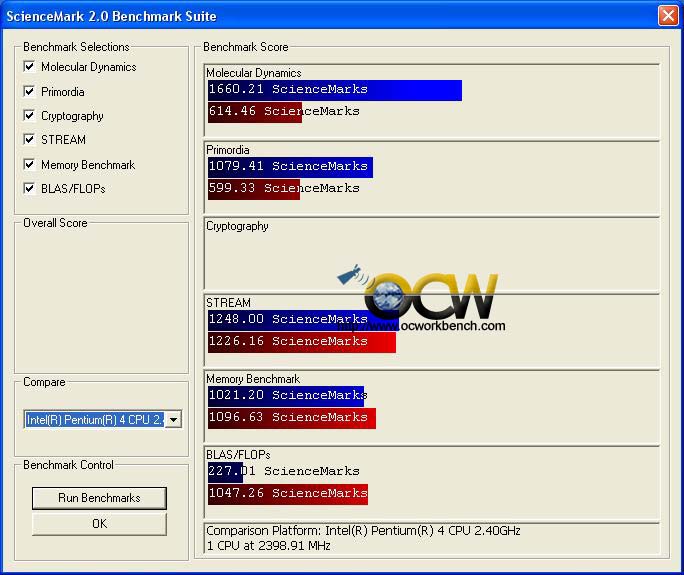Benchmarks -
Sciencemark 2
Sciencemark 2
Science Mark 2.0 is an attempt to put the truth behind
benchmarking. In an attempt to model real world demands and performance, SM2 is
a suite of high-performance benchmarks that realistically stress system
performance without architectural bias.
"MemBench" - An unbiased, synthetic benchmark that
sweeps through more than 15 different, publicly available, memory copy
algorithms to measure the peak memory performance of your CPU’s caches and your
memory subsystem.
"BlasBench" - Scientists and engineers use large matrix
multiplication to determine peak MFLOPS. BlasBench measures the MFLOPS of your
machine via large matrix multiplication. The benchmark can be run in single or
double precision. Real world matrices are often large and don't fit into the
processor's cache. Science Mark 2’s optimized implementations of matrix
multiplication in single and double precision, from an algorithm point of view,
perform remarkably better than the blind man's matrix multiplication routine.
BlasBench uses building blocks called kernels at its lowest level that determine
overall MFLOPS performance. These kernels are written in C and a wide assortment
of assembly forms (SSE Vector, SSE2 Vector, SSE2 Scalar, x87, 3DNow! Vector) to
support any processor architecture in the x86 market.
"MolDyn" - Science Mark 2.0 performs Molecular Dynamics
Simulations. It has the flexibility of simulating any 5 noble gases, in 3
different crystallographic configurations, with variable numbers of atoms at a
user specified temperature.
"Primordia" - Science Mark 2.0 computes the electronic orbitals
for the atoms between Hydrogen and Promethium in the periodic table using a
Restricted Hartree-Fock method. Primordia outputs the total all electron energy
of the atom in addition to the kinetic and potential contributions. The user is
allowed to specify different grids upon which the orbitals are determined.
"QMC" - The Primordia orbitals are utilized to simulate and
determine the properties of molecules using the extremely accurate quantum Monte
Carlo algorithm. Primordia and QMC are indicative of what is done in commercial
chemistry codes on workstations and supercomputers about the world.
"FEM" - The behavior and properties of fluids and structures is
modeled using the Finite Element Method. Similar tasks are performed by
automotive, aerodynamic and civil engineering companies during their product
design.
"Cipher" - Benchmark tests four different forms of encryption
algorithms, AES 128/256 bit and RSA 512/1024 bit. Sean's AES 128 bit encryption
algorithm is quite possibly the fastest implementation on the face of the earth.
From the scores, we can see the good of Dual
Core especially in Molecular Dynamics, Primordia and BLAS/FLOP tests. The scores
obtained are again very close to the ones obtained on Gigabyte board.

Score of Foxconn 955X7AA-8EKRS2

Score of Gigabyte 8I955X Royal
Discuss in
Forum
Next >>>